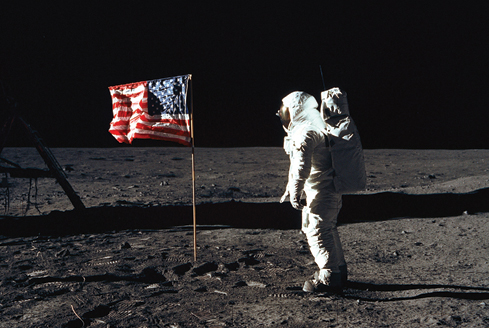 Winter 2012
Winter 2012|
"The memories of the evening of July 20, 1969, are vivid for almost anyone who lived at that time. That was the day the United States put a man on the moon. It meant that anything was possible."
|
It could have been just any summer evening, Sunday, July 20, 1969. But that evening was anything but ordinary. Decades before the two of us knew each other, one of us dawdled with friends on the streets of Shaler Township, just north of Pittsburgh, anxiously checking in at home every 15 minutes or so to see if there was any news. The other finished a waitressing shift at the Zelienople Howard Johnson’s on the Pennsylvania Turnpike and rushed home to take a seat in front of the television with the rest of the family. The memories of the evening of July 20, 1969, are vivid for almost anyone who lived at that time. That was the day the United States put a man on the moon. It meant that anything was possible.
Man has been fascinated with the cosmos since time immemorial. And by the 20th century, people were able to explore the skies in planetariums—wondrous theaters where the solar system was projected. The Buhl Planetarium and Institute of Popular Science, located on Pittsburgh’s North Side in the building that now houses the Children’s Museum, first opened its doors in 1939 as the fifth planetarium in the country. Hundreds of thousands of visitors have seen spectacular sky shows in the “old Buhl” as well as the “new Buhl,” which moved to the then-newly established Carnegie Science Center in 1991. It’s a timeless experience—gazing at the planets, imagining oneself traveling in outer space. Here at the Science Center, astronomy is a deep legacy of our past and a “forever” part of our future. For the past several years, we’ve been planning for a new space-themed exhibit to complement our digital planetarium and rooftop observatory. We’ve wanted to bring hands-on excitement to address the public’s fascination with manned space exploration, new research technologies, and ever-evolving theories about the nature and origin of the universe. Our new permanent SpacePlace gallery, complete with a weightlessness experience, will surely intrigue and inspire all generations— those, like us, who remember that summer day in 1969 when a man first walked on the moon, and those who were born decades later. We’re proud to bring it to the region.
Ann M. Metzger
Ron J. Baillie
|
Our Place in Space · Breaking Out of the Cube · Reimagining Home · Southern Exposure · NewsWorthy · Face Time: Tina Kukielski · Artistic License: Hacking Reality · Science & Nature: Going Buggy · Field Trip: Where in the World is Carnegie Museums? · The Big Picture
 |
Copyright © 2017 CARNEGIE Magazine. All rights reserved. |



